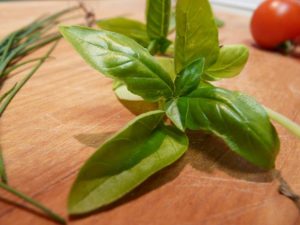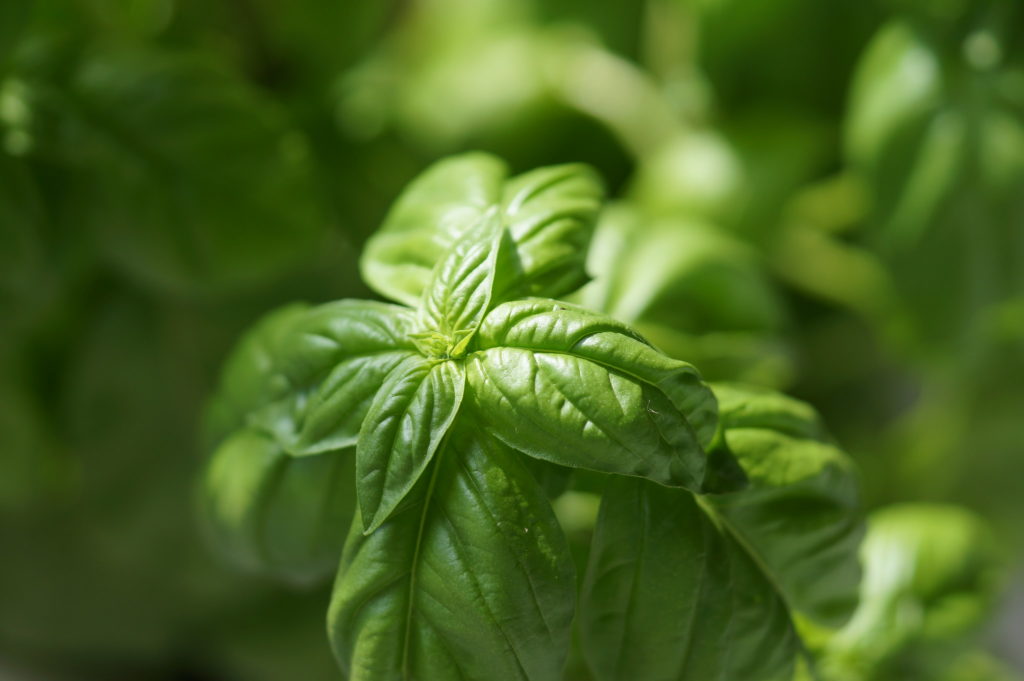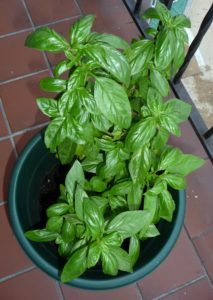Basil is a delicious warm-weather annual to add to your garden. Basil goes great in soups, on pizza, or while making pesto sauce. In the past, basil was used medicinally to treat ailments like the flu, common cold, and acne. Basil is also thought to be an immune booster, so it might be a good idea to cook with basil more often during flu season. Nutritionally basil is packed with vitamin A, K, and flavonoids. Hopefully by the end of this article you will be convinced to grow this herb, and if you need help planning your herb garden, try our garden planner Hortisketch.
Planting Basil

This herb prefers to be grown in raised beds or containers but can grow in-ground outside as well. Start planting basil 2 weeks after the last frost. Plant the seeds a quarter inch deep with at least 12 inches apart. If you’re planting in a container, make sure the container is 12 inch deep and wide. Plant in nutrient rich fertile soil with a pH of 6.0-7.0. To prevent root rot, make sure the soil is well drained. Basil thrives in moist soil, so be sure to water frequently and not let the top inch of soil dry out. Once planted, basil will take on average 75 days to mature, depending on variety. Basil also prefers full sun but can use some reprieve from the sun during Summer months, especially if you live in the South.
While growing herbs like basil there are some companion plants to consider. Many plants that typically go in salads are a great choice. What goes together, grows together! So, planting lettuce, peppers, and cabbage may be beneficial to your basil plants. Other plants that grow well with basil include: oregano, parsley, chamomile, marigolds, asparagus, eggplant, beets, potatoes, and beans.
Harvesting Basil
Harvesting your basil can begin when it is 6-8 inches tall and has at least six leaves on it. Only harvest or prune what you plan to use. If your basil plant begins to flower, it will stop growing, so be sure to pinch or cut off the flowers once they begin to form.
If you decide to harvest some basil for later use, there are a few ways you can store your basil. Freezing your basil is the easiest and will ensure most of the flavor is retained. Chop or pulverize your basil, put it into a plastic bag then pop it into the freezer for later consumption. If you’re seeking to dry your basil, know that it will lose at least half of its flavor. Simply cut and hang the basil leaves in a cool, dark, and dry area until the leaves crumble to the touch. While drying it is critical that the leaves have a lot of natural airflow, or you risk mold growing on the basil leaves. You can also use a dehydrator to dry the basil leaves.

Basil Pest and Diseases
Flea beetles and aphids are the most common pests afflicting basil. Utilizing neem oil and diatomaceous earth as a prophylactic are you best bets. If necessary, apply a heavy coat of neem coil from top to bottom of your basil plants.
Spider mites and whiteflies may also try and ruin your basil plants. Similar to aphids, neem oil is the best solution to fend off these pests.
Japanese beetles, slugs, snails, and grasshoppers will all try and eat your basil plants. Slugs and snails will also leave a slimy trail on all your leaves (gross!). Creating a circle of diatomaceous earth around your basil will help fend off many of these pests. Row covers can be a great solution for keeping beetles and grasshoppers from jumping onto your plants. If on the off chance they still make it to your basil, flick them off and apply neem oil.

Fusarium wilt is characterized by stunted growth, wilting, and yellow or brown streaks. Fusarium wilt is very deadly to basil and unfortunately there is no way to save your basil once it is afflicted. If your plant is infected, you will need to throw it away and avoid planting in that soil for a few years.
Powdery and downy mildew can be a pain but are manageable. If you see signs of yellow or white dust on your basil, this is a sign of mildew. Spraying your basil with neem oil should do the trick.
Cercospora leaf spot is a fungus that causes brown spotting on the basil leaves. Applying fungicide and removing infected leaves should help.
Lastly, Leaf spot disease is a bacterial disease that leaves brown and black streaks on your basil plant. Unfortunately, there is not much that can be done to mitigate this disease once infected. Your best option is to cut and prune away any diseased parts of the basil plant.
Growing Basil Conclusion
Basil is an easy to grow and delicious addition to any garden. Many types of cuisines benefit from basil, so now is the time to start planting basil in your garden! Use our recommendations and your basil garden will be set for success from the start.

Contact Author
 info@gardensavvy.com
info@gardensavvy.com Recent Posts
- Smart Gardening: How Technology Is Revolutionizing Horticulture
- Understanding Gardening Zones: What You Need to Know
- The Right Tools For Your Gardening And Landscaping Needs
- Maximizing Your Harvest: Square Foot Gardening Chart for Beginners
- Holiday Garden Scents: Plants for Natural Aromatherapy in Your Home









